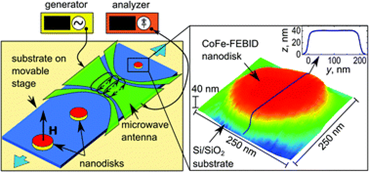
- This event has passed.
Probing spin waves in individual ferromagnetic nanoelements
October 27 , 13:00 – 14:00
Speaker: Prof. Gleb Kakazei
Affiliation: University of Porto, Portugal
Link to MSTeams meeting

A series of our recent experiments on direct-write nanomagnets fabricated using focused electron beam induced deposition (FEBID) will be discussed. First, an original spatially resolved approach for spin-wave spectroscopy of individual circular magnetic elements with sample volumes down to about 10−3 μm3 will be presented [1]. The key component of the setup is a coplanar waveguide whose microsized central part is placed over a movable substrate with well-separated CoFe-FEBID nanodisks (see Fig. 1). The circular symmetry of the disks allows for the deduction of the saturation magnetization and the exchange stiffness of the material using an analytical theory. Next, using this approach, the engineering of the magnetic properties of CoFe-based nanodisks fabricated by FEBID will be demonstrated [2]. The material composition in the nanodisks was tuned in situ via the e-beam waiting time in the FEBID process and their post-growth irradiation with Ga ions. The achieved saturation magnetization Ms variation in the broad range from 720 to 1430 emu/cm3. Further, nanovolcanoes – nanodisks overlaid by nanorings – will be introduced as purpose-engineered 3D architectures for nanomagnonics [3]. The extension of 2D nanodisks into the third dimension allows for engineering their lowest eigenfrequency with 30% smaller footprints. The nanovolcanoes can be viewed as multi-mode microwave resonators. Finally, spin-wave phase shifters upon a single nanogroove milled by a focused ion beam in a Co–Fe microsized magnonic waveguide, characterized by all-electrical spin-wave spectroscopy, will be described [4]. By varying the groove depth and the in-plane bias magnetic field, we continuously tune the spin-wave phase and experimentally evidence a complete phase inversion. The proposed phase shifter can easily be on-chip integrated with spin-wave logic gates and other magnonic devices.
References
[1] O.V. Dobrovolskiy et al., (2020), Nanoscale 12, 21207, (2020).
[2] S.A. Bunyaev et al, Appl. Phys. Lett. 118, 022408 (2021).
[3] O.V. Dobrovolskiy et al., Appl. Phys. Lett. 118, 132405 (2021).
[4] O.V. Dobrovolskiy et al., ACS Appl. Mater. Interfaces 11, 17654 (2019).
Chairman: Jarosław W. Kłos
Theme by Themesmob
